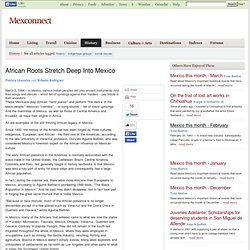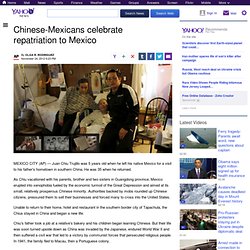

African Roots Deep Into Mexico. Patrisia Gonzales and Roberto Rodriguez March 3, 1996 -- In Mexico, various Indian peoples still play ancient instruments.

And their songs and dances -- which tell of uprisings against their masters -- pay tribute to their ancestors. These Mexicans play African "hand pianos" and perform "the dance of the black people. " Mexican "corridos" -- or song-stories -- tell of slave uprisings. And the marimbas of Mexico, as well as those of Central America and Ecuador, all have their origins in Africa. All are examples of the still thriving African legacy in Mexico. Since 1492, the history of the Americas has been forged by three cultures: indigenous, European, and African - the third root of the Americas, according to the late University of Veracruz professor, Gonzalo Aguirre Beltrán, who was considered Mexico's foremost expert on the African influence on Mexican culture. Prior to independence from Spain, there were numerous slave rebellions throughout the Americas, including in Mexico.
Origins of Vera Cruz Irish - Heroes of Mexico. The Japanese in Mexico. When they sailed across the world in 1897, Asahiro Yamamoto andSaburo Kiyono were in their early 20s.

In May of that year, theyand their fellow sailors landed in a place of searing sun and junglefever. They walked for more than a week into the interior, settling in Acacoyagua,Chiapas. Their dream of growing coffee there failed. Only one member ofthe group returned to Japan. The rest, including Yamamoto and Kiyono, stayed.As many as 20,000 more Japanesefollowed Ashahiro and Saburo to Mexicoin the ensuing decades. Francisca Ono , 80, is the child of Japanese emigrants to Mexico. Asahiro Yamamoto had been dead foryears by the time the youngest of his eightchildren, Francisco Rokuro Yamamoto Cruz,married Kiyono’s granddaughter, MarthaKiyono Sanchez, in 1956. These family histories encapsulatethe little-known story of the Japanesemigration to Mexico that began 110 yearsago. “My upbringing at home inculcated Japanesevalues, like discipline, honor and loyalty,”says Harumi. Chinese-Mexicans celebrate repatriation to Mexico. MEXICO CITY (AP) — Juan Chiu Trujillo was 5 years old when he left his native Mexico for a visit to his father's hometown in southern China.

He was 35 when he returned. As Chiu vacationed with his parents, brother and two sisters in Guangdong province, Mexico erupted into xenophobia fueled by the economic turmoil of the Great Depression and aimed at its small, relatively prosperous Chinese minority. Authorities backed by mobs rounded up Chinese citizens, pressured them to sell their businesses and forced many to cross into the United States.
Unable to return to their home, hotel and restaurant in the southern border city of Tapachula, the Chius stayed in China and began a new life. Chiu's father took a job at a relative's bakery and his children began learning Chinese. They never stopped dreaming of Mexico, and Juan Chiu Trujillo returned in November 1960. Twenty-one of those Chinese-Mexicans and their descendants celebrated for the first time on Saturday the anniversary of their return. Molokans & Jumpers in Baja, Mexico. 17. 5 Babeshoff sisters I first saw this 1947 photo (below) in the section "Russians", in the Gale Encyclopedia of Multicultural America, 1995.

This encyclopedia has essays on 152 culture groups in the U.S., but this section about Spiritual Christians still has mistakes. Most of the section with this photo appears on the web site as Countries and Their Cultures: Multicultural America: Russian Americans, by Paul R. Magocsi, professor University of Toronto, Canada. The the original text and the caption online (below: "Taken in 1947 ... ") omits that the location is in rural Mexico, 35 miles south of the US border. Taken in 1947, this photograph demonstrates the influence of American fashion on traditional Russian dress.
[On November 21, 2008, Elena posted this photo on her The Happy Wonderer blog, with comments about leg crossing, modern shoes and showing leg.